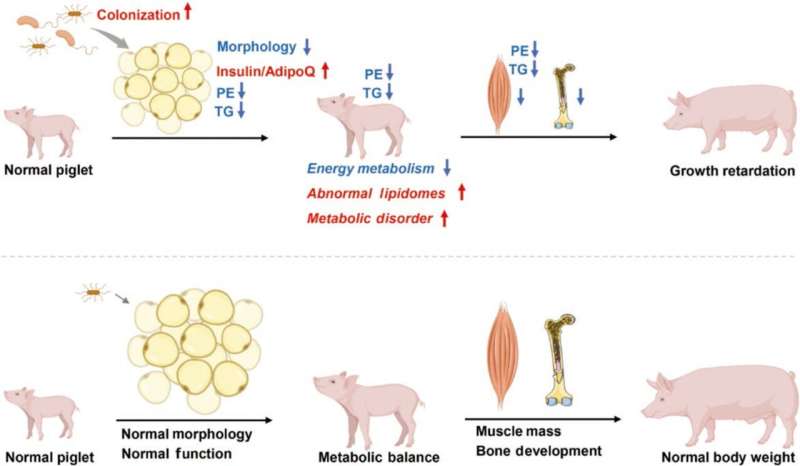This article has been reviewed according to Science X's editorial process and policies. Editors have highlighted the following attributes while ensuring the content's credibility:
fact-checked
proofread
Adipose tissue dysbiosis exacerbates postnatal growth retardation in piglets, study finds

Postnatal growth retardation (PGR) is characterized by poor production performance, low feed conversion rate, and a high mortality rate, the metabolic basis of which in piglets is unclear.
Adipose tissue is a crucial organ for energy storage and endocrine regulation. It plays a vital role in regulating glycolipid metabolism throughout the body as well as in the early growth and development of young animals. Recent studies have reported that microorganisms in the gut and the environment can translocate to adipose tissue and participate in the regulation of systemic metabolism.
For instance, microorganisms in adipose tissue are closely related to obesity, metabolic disorders such as type 2 diabetes mellitus, and Crohn's disease. However, whether specific microorganisms exist in PGR pig adipose tissue and play roles in regulating growth and development remains unknown.
Chinese scientists at Huazhong Agricultural University and Hunan Agricultural University have published an article in Life Metabolism titled "Abnormal adipose tissue-derived microbes drive metabolic disorder and exacerbate postnatal growth retardation in piglet," revealing for the first time that dysbiosis in adipose tissue worsens the PGR in piglets by altering the homeostasis of energy metabolism.
The researchers first characterized PGR models in piglets. Through a large-scale tracking trial and testing some key metabolism-related factors, they found that PGR piglets showed an insulin resistance-like phenotype.
Further analysis of their adipose tissue morphology revealed that the diameter of adipose tissue in PGR piglets was much smaller than that of normal individuals, suggesting that PGR piglets may have disturbed glycolipid metabolism.
To investigate whether microbes exist in the adipose tissue and affect the metabolism of PGR piglets, researchers collected subcutaneous adipose tissue, visceral adipose tissue, liver, blood, and other tissues of PGR piglets, and found that the microbes exactly existed in the adipose tissues of PGR piglets and differed from those of normal individuals.
Notably, Sphingomonas paucimobilis was isolated and identified as a key dysregulated bacterium in the adipose tissue of PGR piglets. The researchers then reproduced growth retardation and metabolic disorders in piglets by gavage of S. paucimobilis in normally growing piglets.
Next, the study found that extracellular matrix (ECM)-related genes in adipose tissue were dramatically upregulated, suggesting that adipose tissue may undergo functional changes in response to bacterial stimulation. Lipids are key signals for adipose tissue to respond to external signals.
Combined with the lipidomic technique, it was shown that the reduction of triglycerides in PGR piglets was highly consistent with the adipose tissue phenotype. At the same time, there was a significant reduction of the phospholipid metabolite phosphatidylethanolamine (PE). Further supplementation of PGR piglets with PE confirmed that PE was effective in ameliorating metabolic disorders and ultimately in alleviating piglet growth retardation.
Collectively, this study reveals that abnormal microbes in adipose tissue affect the growth of piglets by affecting the lipid metabolism of adipocytes, thereby altering the homeostasis of energy metabolism. This study may provide key targets for controlling pig growth and development in the early postnatal period.
More information: Tongxing Song et al, Abnormal adipose tissue-derived microbes drive metabolic disorder and exacerbate postnatal growth retardation in piglet, Life Metabolism (2024). DOI: 10.1093/lifemeta/load052





















